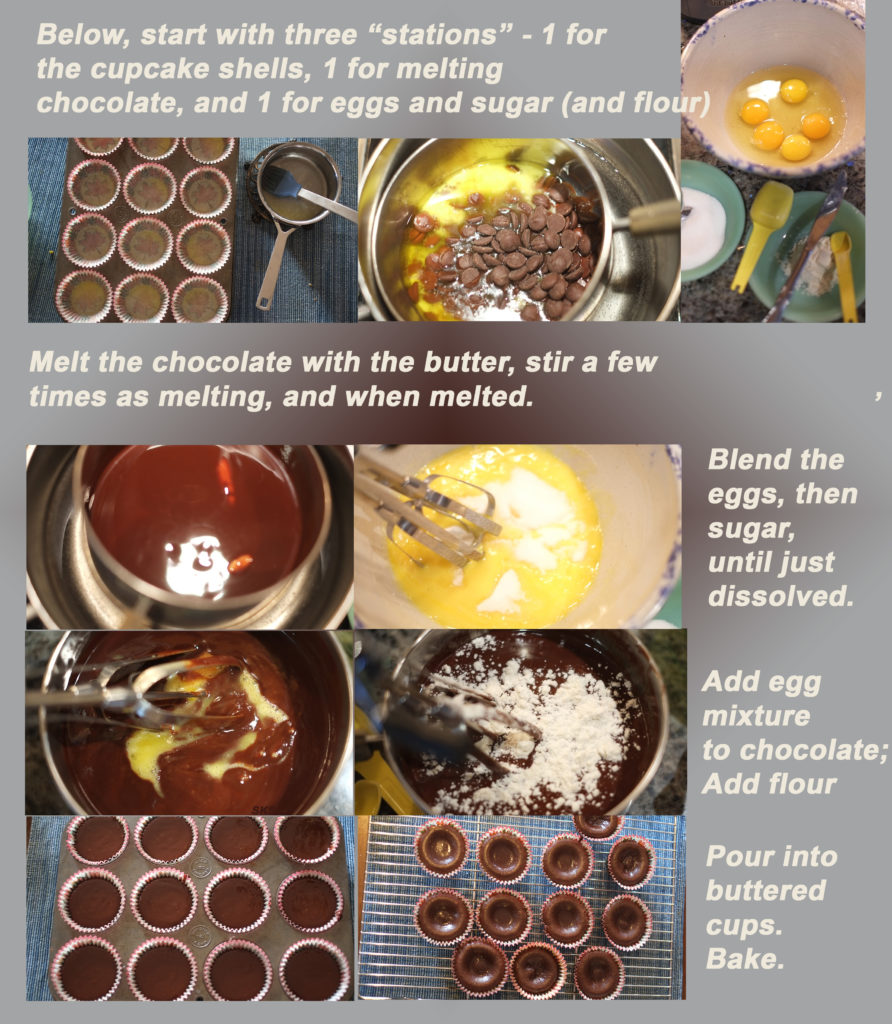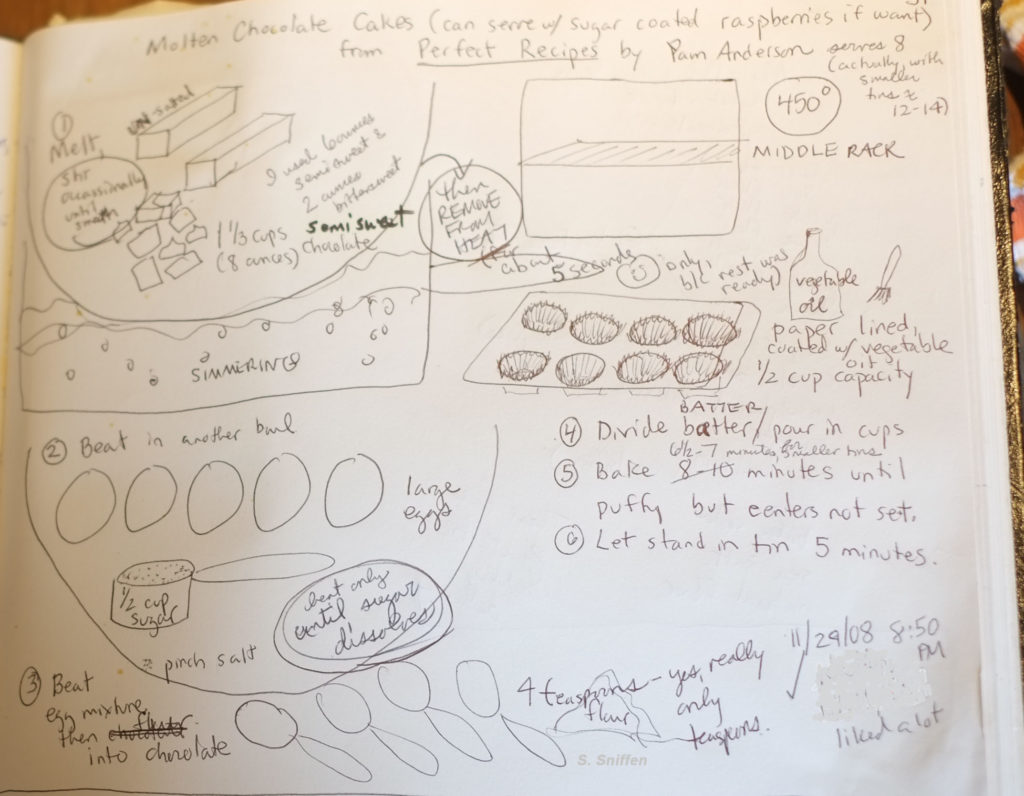Cocoa beans do not grow in the Northeast of the United States, but pair beautifully with eggs and butter produced locally – some local dairies producing butter made by cows eating some local forages and plants, and farms with free-range chickens (chickens choosing nutrients about the farm) collect some fine eggs. Melted center chocolate cakes are a recipe high in butter and good bittersweet chocolate, and eggs.
(See below in pink for recipe reference).
Servings and Cooking Time: These are quite filling, and so the batter can make 12 cakes, and are cooked about 6 1/2 to 7 minutes at 450 degrees Fahrenheit. Good warm, room temperature, and cold!
Ingredients:
2 sticks of butter
8 ounces of bittersweet chocolate
1/2 cup sugar
5 extra large, or large eggs
4 teaspoons flour
(12 unbleached or other cupcake liners [shells])

Tools:
STATION 1:CUPCAKE LINERS
1 3×4 cupcake pan
1 small pan for melting butter with, and
1 brush to spread the butter in the pan
STATION 2: CHOCOLATE MELTING ON STOVE
2 pots with handles, one larger, one smaller
1-spatula
STATION 3: EGG-SUGAR
1- ceramic or glass bowl to beat the eggs in
1- egg beater/blender
measuring spoons (or a teaspoon)
knife to level flower
2-little bowls, one to hold sugar, one flour
After baking at 450 degrees Fahrenheit, let the melty-molten center CUPCAKES SIT AN ADDITIONAL 5 MINUTES IN THE hot-out-of-the-oven CUPCAKE PAN as the recipe by Pam Anderson (see the reference below – in the raspberry colored text block), suggests.
A NOTE ON INGREDIENTS AND METHOD: Bittersweet chocolate is great with the 1/2 cup of sugar, though other chocolates and amounts of sugar can be used. The cupcake paper linings were coated with butter which adds no additional ingredients to the outside layer of the cupcake (as long as the paper does not add taste).
QUICK STEPS: When the ingredients are put together, it all happens quite quickly, and so a way to progress smoothly is to set up three stations, and make sure all is readied, and the oven is about to temperature, before beginning to put all together. The three stations are shown in the photo story above with text, at the top.
DOUBLE BOILER: Note that the chocolate is melted with a double boiler – the top middle photo shows two pots to make the double boiler, the larger with simmering water, and the smaller placed in the water, or just over the water, of the larger pan. The white bit is light reflecting off the chocolate, not cream – the photo is not modified, though, (and October 31st is approaching), it seems to have two eyes, and a smile. A couple yet unmelted butter chunks can be seen in it.
FINAL STEPS: Mixing in the flour was done both with the hand blender a bit, and just stirring. The smaller pot is quite good for pouring, the batter into the cupcake liners, though a small spatula or rubber scraper can help with drips when pouring into the cupcake liners.
For Dogs? No.
Dogs should not eat chocolate in any quantity -this can have long-term consequences. Of course, there is perhaps the exception – I have heard people say their dog ate some, and was ok, which makes me wonder if it is every cocoa bean is not good for dogs, or if only some, or if it is a question of quantity, or of the processing of the beans, or also what is put with them once made into a chocolate bar – that said, to be safe, it is suggested no chocolate for dogs.
Variation:
Adding some fresh herbs and fruit (such as mint, wintergreen, cinnamon, bearberry, a few wild cherries, or lavender), or herb combinations into a bit of cheesecloth or a mesh ball into the chocolate while melting, could make a delicious herbal variety. A ground nut sprinkled over the top might add crunch and be a fine complement to the melted chocolate below.
References: This recipe is based on a recipe by Pam Anderson “Molten Chocolate Cakes with Sugar Coated Raspberries”, on page 264 of her “Perfect Recipes for Having People Over” cookbook.
A web-search on the history dish explains that a chef invented, or re-invented, the recipe in 1987. The recipe may also have been already known at some time and place – methods are discovered through chance, mistake, sense, invention, happenstance… and so the recipe might already have been known down the street, in another country, or at another time, in the same, or similar form, and even so, been invented in 1987 (though in 1987 maybe not invented for the first time). How exciting it must have been for chef – Mr. Vongerichten.

